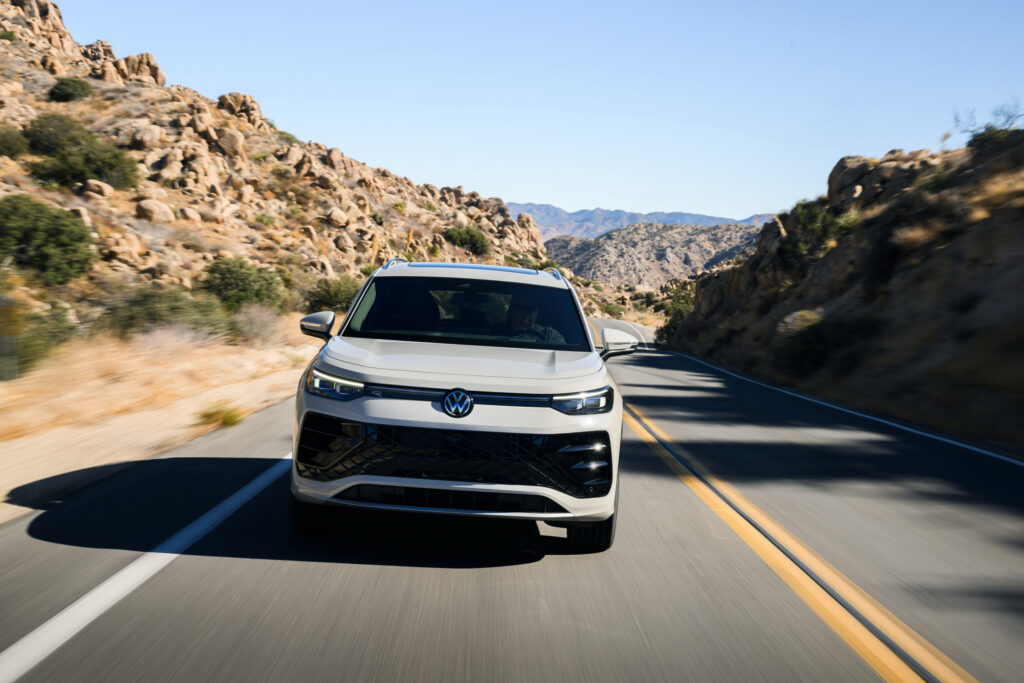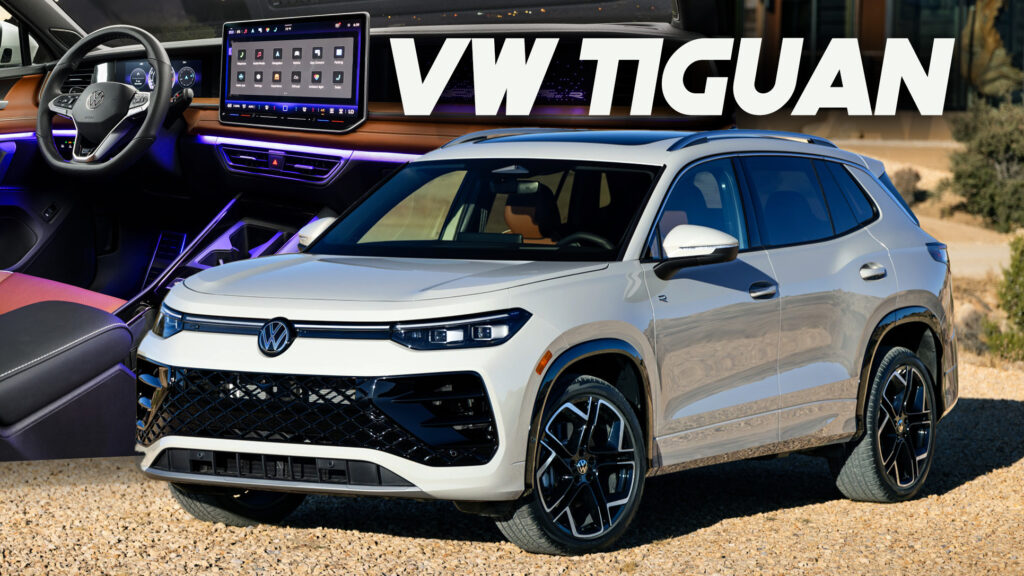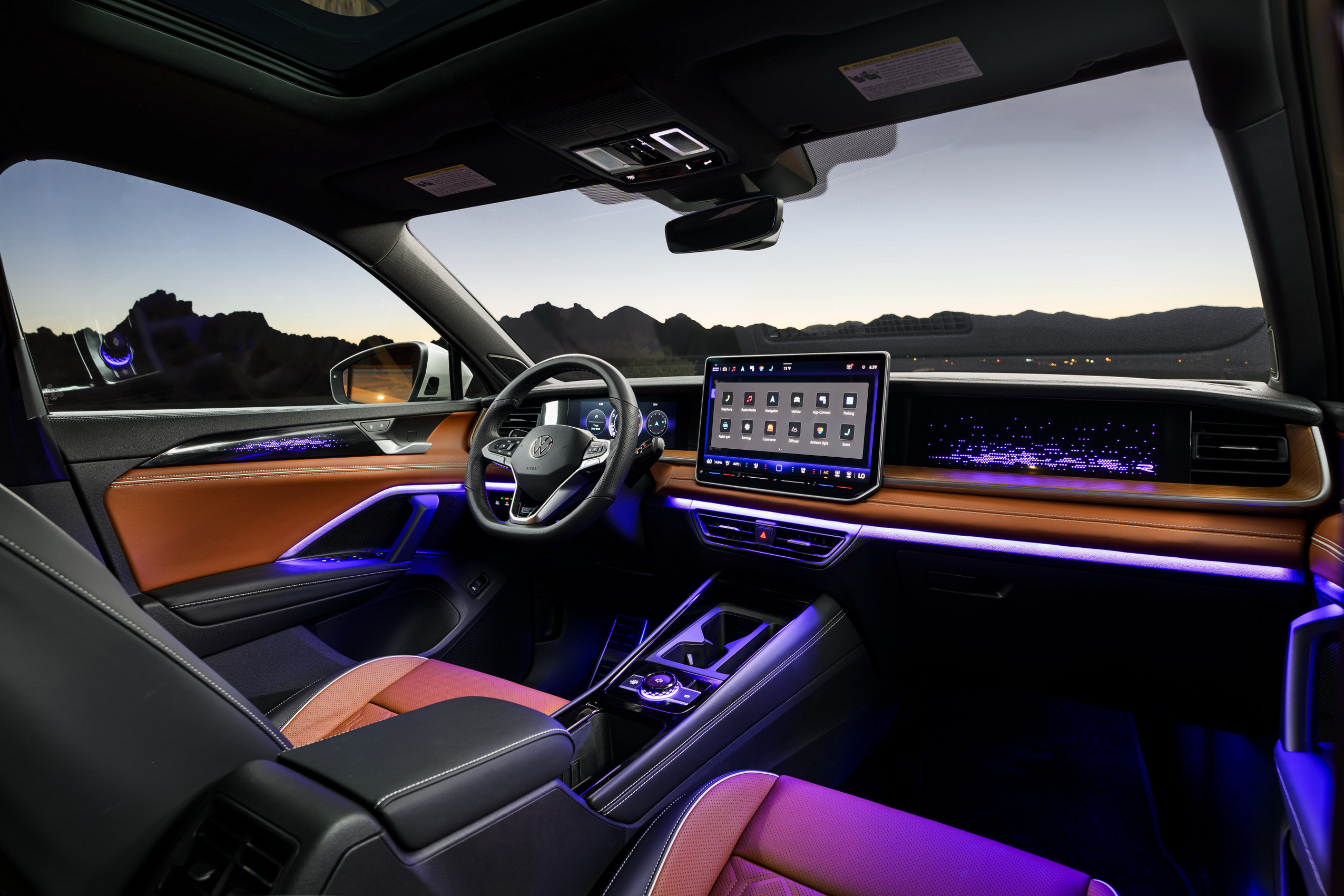- VW of America has unveiled the redesigned Tiguan, ahead of its debut at the LA Auto Show.
- The SUV echoes the European Tayron, but will be offered exclusively with two rows of seats.
- Power is provided by a turbocharged 2.0-liter four-cylinder engine producing 201 hp.
The Tiguan is Volkswagen’s best-selling vehicle in the United States and consumers bought 76,228 of them last year. Those numbers could grow as the popular compact crossover is getting a complete redesign for the 2025MY.
Looking virtually identical to Europe’s Tayron, the 2025 Tiguan sports a modern and expressive design, especially in R-Line guise. The company was surprisingly light on details, but the new model has slimmer headlights that can be connected by an available LED light bar. They can also be joined by an illuminated logo as light is the new chrome.
More: New VW Tayron Introduced In Europe, Previews America’s 2025 Tiguan
Moving further back, we can see curvaceous bodywork and 17- to 20-inch wheels. However, most ‘volume trims’ will have 19-inchers. Regardless of the size, they’re surrounded by pronounced wheel arches with black trim. The rear end closely echoes the Tayron as there’s a slender light bar and a familiar bumper. However, Americans get vertical reflectors instead of horizontal ones.
Volkswagen has opted to keep detailed specifications under wraps for now but did confirm that the new model features a slightly longer wheelbase and a shorter rear overhang compared to its predecessor. That said, the photos suggest it’s shorter than Europe’s three-row Tayron and nearly identical to China’s two-row Tayron L, which measures 4,684 mm (184.4 inches) in length, 1,854 mm (73 inches) in width, and 1,685 mm (66.3 inches) in height, with a 2,791 mm (109.9 inches) wheelbase.
The company also noted that the 2025 Tiguan offers a power liftgate as well as a revised color palette that includes three new options known as Avocado Green Pearl, Sandstone Uni, and Monterey Blue Pearl.
A Modern And More Upscale Cabin
The previous model’s dated interior has been relegated to the dustbin of history and drivers will find a new 10.25-inch digital instrument cluster and a 12.9-inch infotainment system. If the latter isn’t large enough, a 15-inch display will also be available.
The screens aren’t the only big change, as the new Tiguan eschews a traditional center stack and sees the shifter moved to the steering column. This frees up a lot of space and the console now houses a multi-function rotary control dial with an integrated display. It can be used to adjust the volume, change drive modes, and switch between “Atmospheres” which tie the ambient lighting system to the audio system.
Unlike Europe’s Tayron, the North American Tiguan is exclusively a five-seater. It will come with cloth seats that have an embossed design, promising to give the cabin an “upscale feel.” Volkswagen also said a wireless smartphone charger and an automatic climate control system will come standard.
Higher-end variants sound even more impressive as they’ll offer quilted leather front seats with heating, ventilation, and massage settings. They’ll be joined by a heated steering wheel and a heated second-row.
Besides fancier seats, there’s American walnut wood trim and a tri-zone climate control system. Buyers will also find a head-up display, a 30-color ambient lighting system, and a 12-speaker Harman Kardon premium audio system.
The IQ.Drive suite of assistance systems comes standard on all trims and includes Adaptive Cruise Control with Stop and Go, Travel Assist, Front Assist, Rear Traffic Alert, and an Active Blind Spot Monitor. They’re joined by Lane Assist, Emergency Assist, and Light Assist. Other safety features include Park Distance Control, Exit Warning, and four new airbags – driver knee, center, and rear sides – pushing the total up to ten.
Lighter And More Powerful
The 2025 Tiguan rides on the MQB evo platform and is powered by a turbocharged 2.0-liter four-cylinder engine developing 201 hp (150 kW / 204 PS). That’s a small increase of 17 hp (13 kW / 17 PS), but it’s accompanied by a weight reduction of around 170 lbs (77 kg) thanks to the use of high-strength steel and aluminum suspension components.
These changes should pay dividends to drivers as Volkswagen said we can expect improved acceleration as well as better fuel economy. While it’s too early to talk numbers, the outgoing model returned up to 24 mpg city, 31 mpg highway, and 27 mpg combined.
We’ll learn more details closer to launch, but we wouldn’t be surprised if pricing creeps a little higher. If that’s the case, expect to shell out around $30,000.







































































